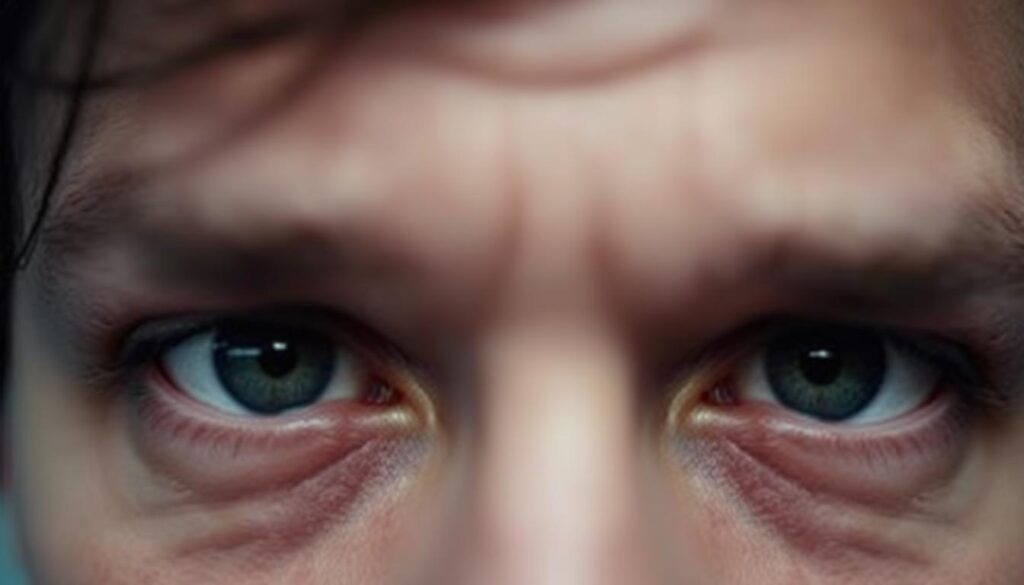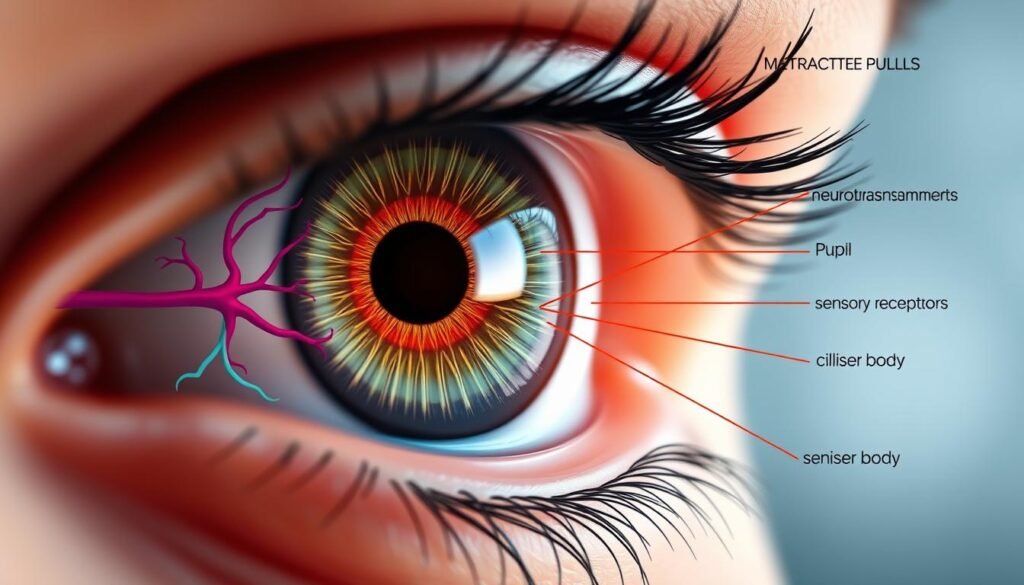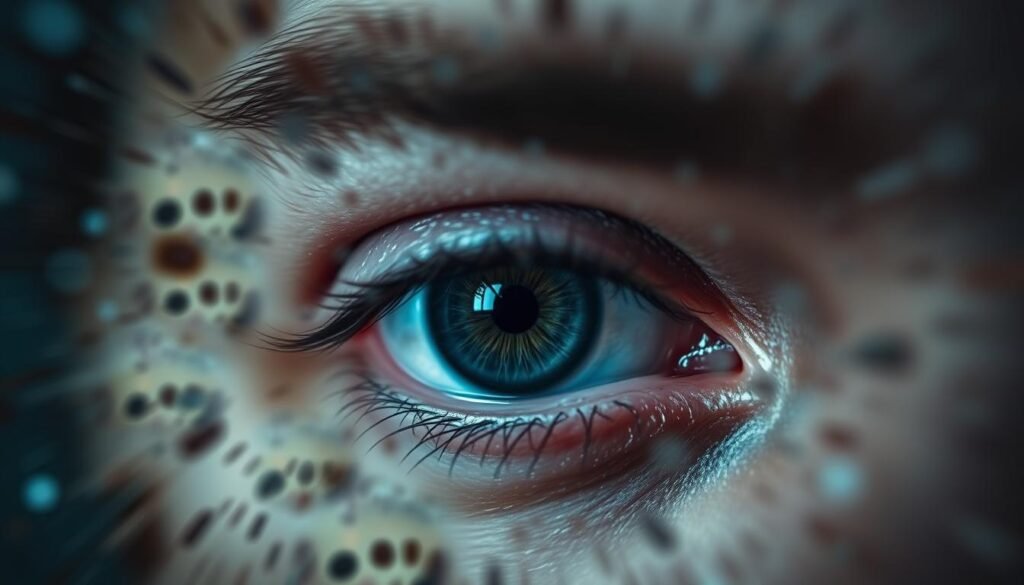Did you know pupil size can change when someone is really anxious? This happens a lot in people with panic disorders or PTSD. It’s a big clue about how our feelings and physical state are linked. By understanding this, we can learn more about our bodies and minds.
Learning about the connection between small pupils and anxiety sheds light on why we feel the way we do. It’s important because it helps us understand ourselves better. This knowledge is not just personal. It has a lot to say about our overall emotional health.
Key Takeaways
- Small pupils may indicate elevated anxiety levels.
- Individual reactions during panic attacks often involve significant changes in pupil size.
- Pupil dilation is linked to the body’s fight-or-flight response.
- A physical response to anxiety can affect vision, leading to symptoms like blurred vision.
- Regular eye health assessments are essential to monitor anxiety-related visual issues.
- Stress management techniques can help alleviate both anxiety and related eye symptoms.
Understanding Pupil Size and Its Normal Function
Pupil size tells us a lot about normal pupil function. It changes with light and when we think hard. In bright light, pupils get smaller, between 2 to 4 millimeters. This helps protect the eyes. But in dim light, they grow bigger, from 4 to 8 millimeters. This lets in more light to help us see better.
The light response of our body is managed by the autonomic nervous system. It adjusts our pupil size. If the sympathetic branch is triggered, our pupils get bigger. The parasympathetic system does the opposite. So, pupil size affects our vision and also shows emotions and how hard the brain is working. For example, bigger pupils mean we are focusing more on something.
Research has linked pupil size with emotions. Positive or negative things we see or read can change it. Anxiety can also affect it, making pupils less responsive in tough times. This connection between pupil size, mind work, and feelings is fascinating.
| Lighting Condition | Pupil Diameter (mm) | Functionality |
|---|---|---|
| Bright Light | 2 – 4 | Constricts to protect retina |
| Dim Light | 4 – 8 | Dilates to increase light intake |
Knowing how pupil size changes is key. It’s not just about seeing well. It also tells us about emotional and mental states. For more about how anxiety affects the body, like causing numbness, check out this resource.
What Are Small Pupils?
Small pupils are often called abnormal miosis. They measure less than two millimeters across. This is different from how pupils usually react to light. Normally, they change size from two to eight millimeters.
Having small pupils might indicate health or mental issues. For instance, using drugs like heroin can cause miosis. This comes with other signs such as red eyes and losing weight. Some blood pressure medicines can also lead to small pupils. It’s wise to talk to a doctor about these effects.
Congenital and acquired are two types of miosis. Babies born with miosis have the congenital type. The acquired form happens from things like drugs, head injuries, or toxins. Anyone with small pupils all the time should see a doctor, especially if they have other worrying symptoms.
Certain diseases like anterior uveitis and Horner’s syndrome also cause small pupils. Getting the right diagnosis and treatment quickly is important. If left untreated, small pupils could lead to serious issues. Sometimes, they are linked with feelings of anxiety or stress.

If you want more info on small pupils and related problems, check out this article. Knowing when to get help for abnormal miosis is key to handling health dangers well.
The Biological Mechanism Behind Miosis
Miosis happens when your pupils get smaller. This is because of how eye muscles work. The iris has two main muscles: the sphincter muscle and the dilator muscle. The sphincter muscle makes the pupil smaller. This reduces light coming into the eye. You see this when your body’s parasympathetic nervous system is more active.
Let’s talk about how your pupils react. The sphincter muscle in the iris is key for making them small. The parasympathetic nervous system controls this. Usually, your pupils are smaller when you’re relaxed. First, light hits your retina. Then, signals go to your brain and finally tell the sphincter muscle to contract.
What about when your pupils get bigger? That’s the dilator muscle’s job. It works when you’re excited or stressed, making your pupils larger. Signals from your brain tell the dilator muscle to work. This changes how much light enters your eye. The size of human pupils can change a lot, from 2 to 8 mm.
Stress and certain body chemicals also play a role in miosis. When you’re stressed, it might cause your pupils to get smaller in certain situations. It’s fascinating how our bodies and eyes respond to what we feel. The way eye muscles and our nervous system interact is complex but interesting.

How Small Pupils and Anxiety are Related
The link between small pupils and anxiety is seen when looking at how our bodies react to stress. Our bodies release stress hormones during these times, affecting our pupil size. This shows us how physical signs of anxiety can appear.
The Role of Stress Hormones in Pupil Size
Anxiety triggers the release of adrenaline, a key stress hormone. This hormone gets our bodies ready for immediate action, causing various changes. One such change is pupil constriction. While normal pupil size is between 4-6 mm, anxiety can shrink them to under 2 mm, known as miosis. This reaction helps us see better in urgent situations.
The Fight-or-Flight Response and Pupillary Light Reflex
The fight-or-flight response is vital in dealing with threats. In these times, pupils constrict. This limits light intake and helps focus on potential dangers. This shows the clear link between small pupils and anxiety. Stress makes our bodies react, tightening the pupils to improve our vision and speed of response. This natural response has been key to human survival, highlighting how our pupils react under anxiety.

Small Pupils and Anxiety: What’s The Connection?
Anxiety triggers many physical changes in the body. This is mainly due to the sympathetic nervous system. It plays a big role in how we react to stress or perceived threats, affecting our body’s operations. This includes changes in pupil size for those with anxiety disorders. It’s important to understand how this connection works. This understanding can help us see the impacts on both our bodies and minds.
Sympathetic Nervous System Activation
When we feel anxious, the sympathetic nervous system kicks in. This leads to the “fight or flight” state. The body reacts in many ways to prepare for danger or to run away. One thing that happens is changes in pupil size. Often, pupils may get smaller as the body reacts to stress. Looking at pupil size can tell us a lot about a person’s anxiety level and feelings. Research shows a clear link between feelings of anxiety, the body’s reactions, and changes in pupil size.
Impact of Anxiety Disorders on Pupil Size
Many kids and teens face anxiety disorders, ranging from 8 to 11% of them. Conditions like panic disorder and PTSD show clear patterns in pupil size changes. During panic attacks, which can last a few minutes, pupils might constrict with rising anxiety. Anxiety signs in children, like extreme shyness, could affect pupil size too. Understanding these changes is crucial for parents and caregivers. It helps them support their kids better when dealing with anxiety.
Potential Causes of Miosis Beyond Anxiety
Small pupils, or miosis, can come from many reasons besides anxiety. It’s key to know the causes of miosis for insights into health issues and meds affecting the eyes. Knowing why it happens is critical for handling it right.
Medications and Their Impact on Pupillary Response
Some meds are known to make pupils small as a side effect. These include:
- Opioids: Drugs like morphine and codeine lead to tiny pupils.
- Antihypertensives: Blood pressure meds, such as beta-blockers, can shrink pupils too.
- Cholinergic agents: They boost acetylcholine, which makes pupils small.
These meds affect people in different ways. It’s wise to talk to a doctor if your pupils change.
Medical Conditions Associated with Small Pupils
Some medical conditions can also make pupils small, pointing to possible health issues. Key conditions include:
| Medical Condition | Description |
|---|---|
| Horner’s Syndrome | A neurological issue leading to droopy eyelids, small pupils, and less sweating on one face side, usually from nerve damage. |
| Anterior Uveitis | An inflamed uvea can make the pupil size reduce because of muscle contraction. |
| Adie’s Pupil | This neurological problem makes one pupil bigger than the other and not respond well to light; it can sometimes make the other pupil small. |
Recognizing Symptoms of Anxiety Disorders
It’s important to know the symptoms of anxiety disorders. People with anxiety may show physical and emotional signs. For example, they might have changes in their mood or pupil size. Panic attacks are a common symptom. They can make a person’s pupils change size.
Panic Attacks and Their Effects on Pupils
Panic attacks cause scary symptoms like a fast heartbeat, hard breathing, and feeling dizzy. When someone has a panic attack, their pupil size might change a lot. This is because their body reacts to fear. It’s a sign of how strong their emotions are at that moment. These symptoms show there might be a bigger anxiety problem.
Link Between Emotional States and Pupillary Changes
Emotions and pupil changes are closely linked. When people feel scared, stressed, or anxious, their pupils can change size. This happens because of the autonomic nervous system. Depending on the emotion, pupils can get bigger or smaller. Knowing these signs can help understand anxiety disorders better. It can also encourage people to seek help. For more about anxiety disorders, check out this resource.
Tips for Managing Anxiety and Monitoring Eye Health
Managing anxiety is crucial for your well-being and your eyes. If you’re feeling anxious, try methods that help both your mind and eyes.
- Practice Mindfulness Meditation: It teaches you to be more aware. This can lower your stress and help keep your eyes healthy.
- Regular Exercise: Moving your body every day can lessen anxiety. Studies have found exercise reduces stress, which is good for your eyes.
- Seek Psychological Support: Talking to a therapist helps understand and tackle stressors. This can make anxiety easier to handle.
Keep an eye on your pupil size. It can tell you a lot about your stress levels. If you notice big changes, see a doctor. Knowing how anxiety affects eye conditions like glaucoma is key. Stress can increase eye pressure, making problems worse.
| Tip | Benefits |
|---|---|
| Mindfulness Meditation | Helps control emotions and lowers stress. |
| Regular Exercise | Reduces anxiety and boosts overall health. |
| Psychological Support | Makes it easier to deal with anxiety. |
| Pupil Monitoring | Shows if anxiety changes, helping you seek help sooner. |
Building a support network, learning more about your health, and seeing eye doctors regularly make a big difference. Understanding stress and eye problems is being studied more. The goal is to find better ways to help people with these issues.
Conclusion
Knowing how small pupils link to anxiety is key for understanding our emotions. This article explained the science behind pupil size changes. These changes often happen because of stress and worry.
Pupil size can show how a person feels inside. It gives us a peek into their mental state. Studies say kids with anxiety might have smaller pupil reactions to emotional situations. This fact connects pupil size to anxiety and overall health.
Besides just being observed, small pupils might signal deeper mental health issues. Research involving 117 mother-child pairs found that kids of depressed mothers react differently to sad things. This means small pupils can point to depression and anxiety in people. More about this is discussed in this study. It shows pupil size can measure emotional control.
It’s very important to notice if someone has small pupils because of anxiety. Getting help for anxiety symptoms is not just good for now, but also for a person’s future emotional state. With life’s stress growing, knowing about pupils and feelings helps us take care of our mental health.